The Arising of Body and Mind
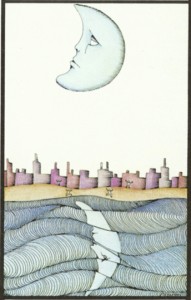 The next link in the chain of Dependent Origination is nama-rupa, which usually is translated either as “name-and-form” or “mentality-materiaity.” Christina Feldman uses “mind-and-body.” She says, “Nama, or ‘mind,’ describes the feelings, the perceptions, the intentions, the kind of attention that we give to what appears in the field of our awareness.” So nama is the whole movement of mind in all its components in relationship to the “body” of physical/material phenomena (rupa). The way it works is that “there’s the arising of rupa and then nama creates concepts or attitudes about it.
The next link in the chain of Dependent Origination is nama-rupa, which usually is translated either as “name-and-form” or “mentality-materiaity.” Christina Feldman uses “mind-and-body.” She says, “Nama, or ‘mind,’ describes the feelings, the perceptions, the intentions, the kind of attention that we give to what appears in the field of our awareness.” So nama is the whole movement of mind in all its components in relationship to the “body” of physical/material phenomena (rupa). The way it works is that “there’s the arising of rupa and then nama creates concepts or attitudes about it.
Christina continues, “The kind of relationship we have with any rupa, including our own body, is shaped by what’s going on in the mind, whether we are aware of it or not.
“So the shape of the mind and body, this nama-rupa, is always changing, always moving, never staying the same. Consciousness, body and mind are always interdependent. Consciousness leads the body and the mind to function in a certain way. If consciousness has arisen flavored by anger or by greed, by depression, by anxiety…or whatever…it provides the conditions for the body and mind to organize itself in a particular way. We can have a sad body, an angry body, a fearful body….and that sense of body is not only what is happening physically, but also what is happening in the mind.”
I like the simplicity of “mind/body” as translation for nama/rupa, but it’s not just our own mind and body that we’re talking about. It’s all the forms that appear in awareness, and the mental response we have to them. I prefer “mentality/materiality,” but it’s too much of a mouthful. I’m tempted to go with “things-and-thoughts,” for the alliteration if nothing else. But that suggests too much of a split. The physical “thing” is inseparable from our mental response to it. (As in the image I chose of the moon and its reflection.) I like the way nama suggests “name,” so for the homework assignment, I’ll go with “name-and-form.”
(image: Maddonni Tarot)
Flavor of Mind
More on the DPP homework topic of Dependent Origination
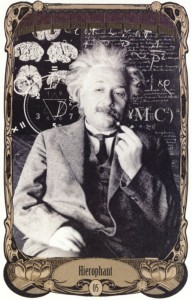 Consciousness (vinnana) is the third link in the chain of Dependent Origination. Christina Feldman says that consciousness “describes the basic climate of the mind at any particular moment–the way the mind is actually shaped, flavored, at any moment…whether it’s aversive or dull or greedy.”
Consciousness (vinnana) is the third link in the chain of Dependent Origination. Christina Feldman says that consciousness “describes the basic climate of the mind at any particular moment–the way the mind is actually shaped, flavored, at any moment…whether it’s aversive or dull or greedy.”
She goes on to say that consciousness also begins to shape how we see the world. As a faculty, consciousness is flavored, so the same object will appear differently to different people, depending on each person’s consciousness and the sankharas (habit patterns) that are present. AND, because everything is interconnected, consciousness is also shaping what is around us. For example, people respond to us differently when we’re angry than when we’re afraid or welcoming or giddy or sad.
“Consciousness” is the usual translation for vinnana. But I find it helpful to think of mind as being shaped with a kind of “flavor,” depending on circumstances….so for the homework assignment, I’m translating vinnana as “flavor of mind.”
(image: Steampunk Tarot by Curly Cue Design)
Making Waves
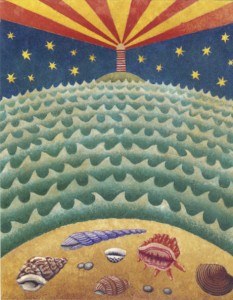 Continuing from yesterday’s post on Dependent Origination:
Continuing from yesterday’s post on Dependent Origination:
One of the DPP homework readings is a transcript of a talk given by Christina Feldman, in which she explains sankhara as “the way ignorance takes form, takes a particular shape or a particular activity–almost the way it rises out of being invisible or unconscious into a more generated or active form that can actually be seen–in body, speech, or mind.”
Sankhara is usually translated as “volitional formations,” but what the heck does that mean? In Kamma and the End of Kamma, Ajahn Sucitto describes sankhara as “behavioral patterns or programs,” and in a recent series of talks I’ve been listening to lately, he uses emotional and psychological “wave formations.” Which I really like because it’s so visual.
As I understand it, sankhara are “things/processes that have come together as a result of past actions, intentions, habits, preference and opinions.” It’s not the most elegant translation, I’ll concede. So I think for the homework assignment, I’ll go with “mental, verbal and bodily wave patterns.”
(image: this is from another one of those cards I’ve had in my desk for years. I have no idea who to credit.)
Not Knowing
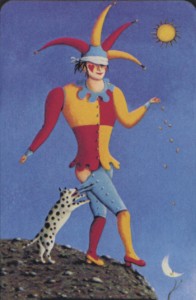 The main topic of the DPP homework for this month is Dependent Origination (paticca samuppada), which is the Buddha’s unique teaching that describes how, out of ignorance, we continue to get caught in suffering over and over again.
The main topic of the DPP homework for this month is Dependent Origination (paticca samuppada), which is the Buddha’s unique teaching that describes how, out of ignorance, we continue to get caught in suffering over and over again.
Let me just say that this is not a simple, intuitive teaching. Which is why we have already spent a great deal of time working on it. This month, part of our homework is to look at the 12 links that make up the chain of Dependent Origination, to consider the various translations of the Pali terms for these links, and then to create a personal list that works for us. (And to find images that represent each of these terms.)
The 12 links are:
Avijja…ignorance, blindness, unconsciousness
Sankhara…karma-formations, patterns and programs, volitional formations
Vinnana….consciousness, cognition, knowing
Nama/Rupa….name/form, mentality/materiality, mind/matter
Salayatana….six senses, sixfold sensory experience, realm of the senses
Phassa…contact, sensory impingement, touch
Vedana….feeling, sensations, sense experience
Tanha…craving, emotional urge, hunger/thirst
Upadana….grasping, clinging, attachment
Bhava….becoming, being
Jati…birth
Jaramarana…aging and dying, old age and death, grief, sorrow, suffering, lamentation and despair
Today, I’m working on avijja. I think I’m going with “not knowing“ as my personal translation.
(image: this illustration is from a tarot deck I’ve had in my collection for years….but I’ve lost the box, so I’m in a state of not-knowing as to the source)
There Is A Seed
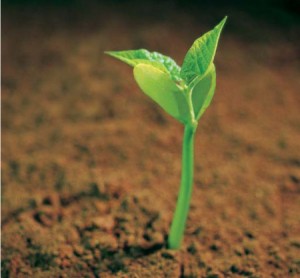 “Though I do not believe a plant will spring up where no seed has been, I have great faith in a seed. Convince me that you have a seed there, and I am prepared to expect miracles.” — Thoreau
“Though I do not believe a plant will spring up where no seed has been, I have great faith in a seed. Convince me that you have a seed there, and I am prepared to expect miracles.” — Thoreau
One of the topics for this month’s DPP homework is saddha, a Pali word which usually is translated as faith….a word that, at least for me, comes with an awful lot of baggage. Saddha is also translated as confidence, conviction, or trust….which I prefer….but there is a kind of power in the word faith….especially when I think about having faith in a seed….that I don’t want to lose.
Here’s part of this month’s focus on faith:
“Saddha, usually translated as faith, is an essential ingredient in the spiritual journey. In the Buddha’s teaching, it is one of the five spiritual faculties necessary for true understanding and awakening, along with energy, mindfulness, concentration, and wisdom.
“Faith is usually placed first because it fuels the whole process. Likewise, doubt (the lack of faith), is the most formidable of all hindrances because it stops us from ever beginning. We are frozen out of even stumbling onto understanding because we never practice in a manner that allows the truth of the dharma to be known. For this reason, a certain amount of faith is not an option, but a necessity.
“Faith requires at a minimum an acknowledgement that the fruit of the dharma (the end of suffering) might be true, and it may be possible that even we, with all our flaws, might experience this fruit. It also requires an acknowledgement that the possibility of attaining such a fruit is worthy of great effort.
“Notice that faith does not require a belief in some force outside ourselves, but rather a realization that we suffer and it might be possible to have it end.
“It creates an unhealthy and unproductive tension to try to force more than this minimum amount of faith. Faith grows because of the insights we have and from our intuitive recognition of the truth of the teachings. As recognition occurs that the teachings are essentially true, faith grows stronger on its own accord.
“At some point a love of the dharma or the Buddha or the sangha naturally occurs. At this point, there is a heartfeld dimension to the practice, a natural devotion.”
***
Of this much, I am sure.
What Would That Be Like?
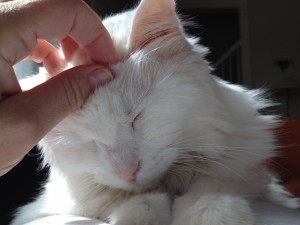 I’ve been spending a lot of time lately reading and listening to talks by Ajahn Sucitto. I especially like the meditation instructions he gives for metta (lovingkindness) meditation (from Kamma and the End of Kamma):
I’ve been spending a lot of time lately reading and listening to talks by Ajahn Sucitto. I especially like the meditation instructions he gives for metta (lovingkindness) meditation (from Kamma and the End of Kamma):
“We often begin a meditation period with recollections and checking in with our general state of being. What is needed is to develop a sense of befriending oneself, establishing an attitude which is non-judgemental and interested in bringing some immediate well-being into one’s life. The most immediate way to bring this around is right here, on the spot where you are, through an applied attitude.
“Establish your presence in the place where you’re sitting, putting other concerns to one side. Then ask yourself, ‘How am I right now?‘ Repeat this slowly a few times and although the bodily sensations or mind-states may change, attend to the more continual overall feeling of what it’s like to be yourself.
“Then consider: ‘What would it be like if….I was in the presence of someone or something that was regarding me with warmth?‘ (You can even recollect your dog…or cat!) Introduce the thought ‘What would that be like? How would I sense that?’ and attend closely to any resonance in the heart.
“Recollect any time in your life when someone was glad to see you, did you a favor, gave you some kindly attention, or enjoyed your presence. ‘How is that, now?’ Then: ‘Does my body know that?’ Attend to any drop in tension, or lift in energy–particularly in the face, and in the heart region.
“Put aside more general reflections or memories of that person or that time, and return to the specific moment and how it felt for you. You may repeat this with a few people and several incidents.
“When you can establish that process, linger in the heart and bodily effect and lessen the thinking accordingly. Gradually simplify and consolidate that process until you arrive at a simple image (of warmth or light for example) or a bodily sense–of ease or joy. Sit with that, sweeping it through your body like a massage.
“As you settle into that, breathe it into your presence. Then expand it out through the skin into the space immediately around you. You may wish to express that benevolence to particular people, or to other beings in general.
“Then bring to mind someone whom you have no strong feelings for. Consider seeing them out of context in which you normally encounter them. Imagine them enjoying themselves, or worried, or in distress. Spend some time rounding out your impression of them in a sympathetic way. ‘May he/she be well.’ Expand your awareness of the feel of that wish; notice how it affects your overall disposition and body tone. Enjoy feeling more empathically attuned.”
(image: my cat, Elvis, and me)
For Your Reflection
 In yesterday’s post, I mentioned my fascination with the idea from Phillip Moffitt’s e-Teaching on The Search for Meaning that we might be co-creating the meaning of life.
In yesterday’s post, I mentioned my fascination with the idea from Phillip Moffitt’s e-Teaching on The Search for Meaning that we might be co-creating the meaning of life.
He goes on to discuss the role of doubt:
“Each of us has a small or large voice inside that says there is no meaning. It’s there in all of us. You don’t need to get that voice to go away; instead, bring it into consciousness. Say to yourself, ‘This is me not believing that anything matters, but that’s just thoughts. Not believing anything matters and there’s no meaning…feels like this.’
“Explore beliefs and trust that however you’re leaning, it doesn’t have to change your behavior. Not only can you tolerate your sense of what’s true for you, you know that it may change. It gives your ego the chance to look at itself and not be afraid.”
Phillip ends with this terrific list of questions which I offer for your reflection:
Do you know what you believe?
Do you believe there’s meaning or do you doubt it? Or, do you believe we’re co-inventing it as we go?
Is your behavior aligned with what you believe?
(image: Kiawah Island beach at sunset, New Year’s Eve)
Creating As We Go
 At the end of the year, I received the latest e-Teaching from Phillip Moffitt’s DharmaWisdom website. The subject was The Search for Meaning, which oddly enough, just sort of floated right over my head. Maybe it’s because I was in holiday overload, but I didn’t even open the email. I just let it sit there in my inbox along with miscellaneous year-end sales promotions, charity pleas and credit card offers.
At the end of the year, I received the latest e-Teaching from Phillip Moffitt’s DharmaWisdom website. The subject was The Search for Meaning, which oddly enough, just sort of floated right over my head. Maybe it’s because I was in holiday overload, but I didn’t even open the email. I just let it sit there in my inbox along with miscellaneous year-end sales promotions, charity pleas and credit card offers.
But then I read it, and it wasn’t the vague over-view that I guess I had been expecting. It contained an idea that I don’t think I’ve ever really considered: The possibility that there isn’t inherent meaning to life, but that there is meaning that we are somehow co-inventing….that we are creating the meaning of life as we go!
Here’s the part of the e-mail that really caught my attention:
“If you can truly commit to “don’t know mind,” you can explore this question of whether life has meaning in a purposeful way. I believe there are three possible truths.
“The first is that there is no meaning outside of our own experience, whether it’s pleasant or unpleasant. If there is no meaning other than the material moment, then our sense of a greater meaning is some combination of superstition and a way of coping with the existential fear of life’s certainties: We will die, we can’t control what happens to us while we’re alive, and we don’t know if there’s any purpose to our struggles and victories.
“The second possibility is that there is meaning to life that is outside the immediate experience. That meaning can be completely predestined, or there can be some room for us to participate in a small or large way, depending on what you believe.
“Lastly is the possibility that there isn’t inherent meaning but there is meaning that we are either co-inventing or inventing by ourselves, i.e. we’re creating the meaning as we go. Maybe we’ve been co-creating the meaning of life from the moment of the Big Bang.”
I find that possibility fascinating.
Check out Phillip’s DharmaWisdom website for more.
(image: me and the sea on Kiawah Island)
Newsworthy
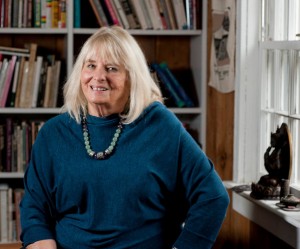 I got back into town yesterday, and to my delight, discovered that my dear, dear teacher — Mirabai Bush — was featured in the Sunday New York Times!
I got back into town yesterday, and to my delight, discovered that my dear, dear teacher — Mirabai Bush — was featured in the Sunday New York Times!
The article is titled Knowing Every Breath You Take, and it’s about the work she’s been doing to bring meditation and its benefits to employees at large corporations — including Google, Yale Law School, Hearst Publications and the Army!
I am deeply grateful to Mirabai and feel a profound sense of connection to her, not only because she was my first introduction to the Dharma. (I was one of the employees at the “large corporation in the Midwest” she mentions in the article.)
Here’s a bit more about her. And here’s more about the Center for Contemplative Mind in Society, which she co-founded.
(image: New York Times)
Till Next Year
 Dharma Town is taking a bit of a break over the holidays, which means that I won’t be posting again until Monday, January 7, 2013. In the mean time, I leave you with these words from Ajahn Chah:
Dharma Town is taking a bit of a break over the holidays, which means that I won’t be posting again until Monday, January 7, 2013. In the mean time, I leave you with these words from Ajahn Chah:
Try to be mindful and let things take their natural course. Then your mind will become still in any surroundings, like a clear forest pool. All kinds of wonderful, rare animals will come to drink at the pool, and you will clearly see the nature of all things. You will see many strange and wonderful things come and go, but you will be still. This is the happiness of the Buddha.
(image: my living room)
